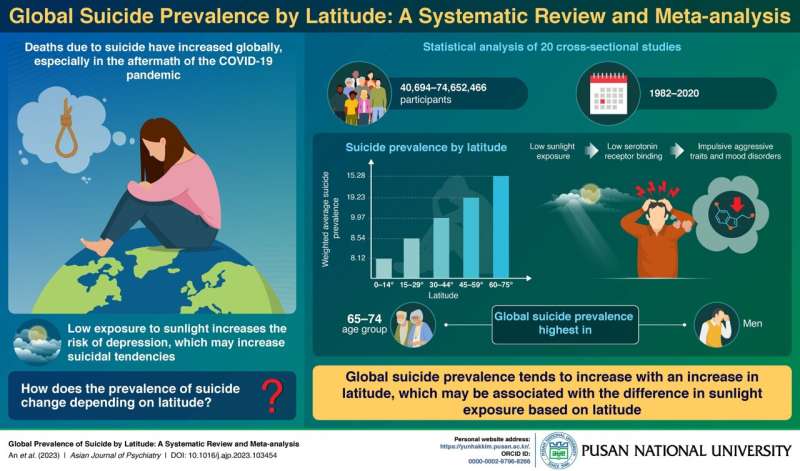This article has been reviewed according to Science X's editorial process and policies. Editors have highlighted the following attributes while ensuring the content's credibility:
fact-checked
proofread
Researchers link suicide prevalence to geographical latitude

Over the years, deaths due to suicide have become prevalent across the globe, with estimates suggesting that almost 800,000 people take their own lives each year. Suicide and self-harm adversely affect individuals, families, and society at large. Other than causing mental distress, they also lead to productivity loss and soaring medical expenses. In 2019, losses associated with suicide reached $490 billion. Lately, there is a growing cause of concern regarding the increased risk of suicide due to the COVID-19 pandemic.
In this light, a research team led by Professor Yun Hak Kim from Pusan National University, South Korea, explored the role of sunlight exposure in the prevalence of suicide.
Discussing the motivation underlying this work, Prof. Kim says, "As latitude increases, cumulative sunlight exposure decreases. It reduces serotonin neurotransmitter binding in blood platelets and the brain, which may promote impulsive aggression and mood disorders, including depression. This biological mechanism interlinks sun exposure to suicide. Therefore, investigating the relationship between latitude and suicide rates is crucial."
Their work was made available in the Asian Journal of Psychiatry.
For this study, the team performed a systematic review and meta-analysis of 20 cross-sectional studies published from 1982 to 2020. Next, they calculated the suicide prevalence per 100,000 people and its trends based on factors such as latitude, gender, age, firearm regulation, and income.
They found that the average worldwide suicide prevalence was 13.34. The prevalence increased with an increase in latitudes, with 8.12, 8.54, 9.97, 19.23, and 15.28 in the 0-14o, 15-29o, 30-44o, 45-59o, and 60-75o latitude ranges, respectively. According to the results of the regression analysis, the value increased by 0.255 with each additional degree. In fact, the latitude change explained nearly 27.3% of the suicide prevalence.
Additionally, while the suicide prevalence in men (25.91) was much higher than in women (5.66), women were likely to have suicidal tendencies at a higher frequency. This "gender paradox" is related to the differences in suicide method fatality, depression rates, alcohol abuse, and cultural taboos between the genders.
The researchers further highlighted that suicide prevalence increased with age, from 1.43 in the 0–14 age range to 15.97 in the 65–74 age range, which could be due to the increased risk of social isolation, economic poverty, and health problems that occur with age. They also noted that while gun-control and gun-permissive countries had similar suicide prevalence values of 16.46 and 15.40, suicide by firearm was more common in the latter.
So, what are the future implications of these findings? "This work is one of the first to establish a scientific basis for the association between exposure to sunlight and suicide. Moreover, it is expected to provide evidence for identifying suicide rates by geographic residence," concludes Prof. Kim.
More information: Seongjun An et al, Global prevalence of suicide by latitude: A systematic review and meta-analysis, Asian Journal of Psychiatry (2023). DOI: 10.1016/j.ajp.2023.103454





















